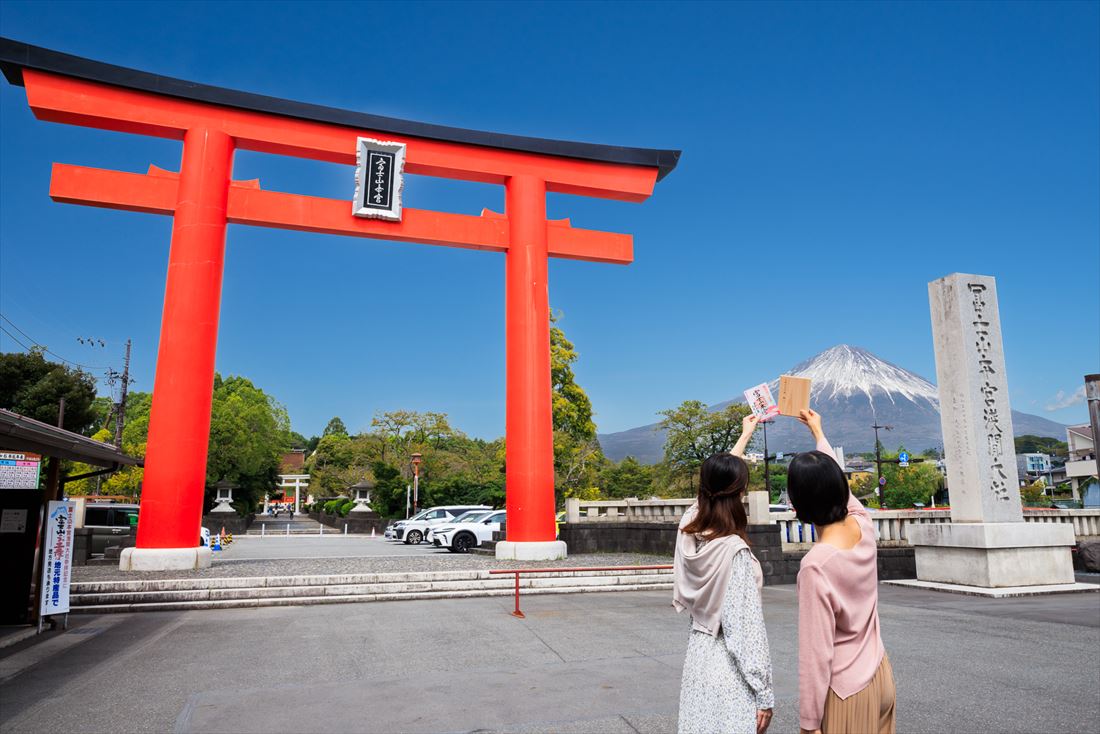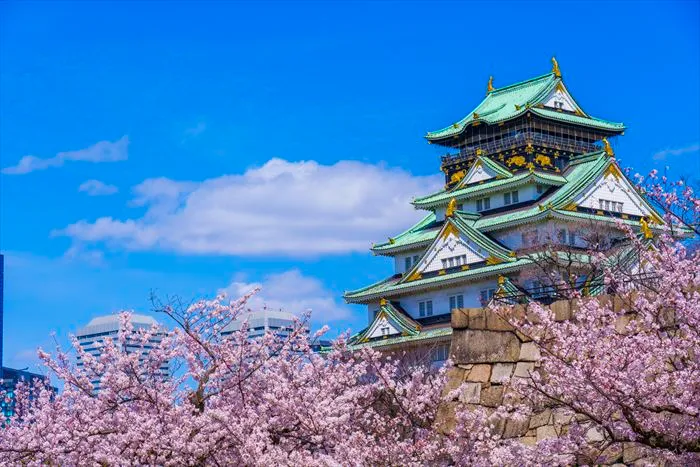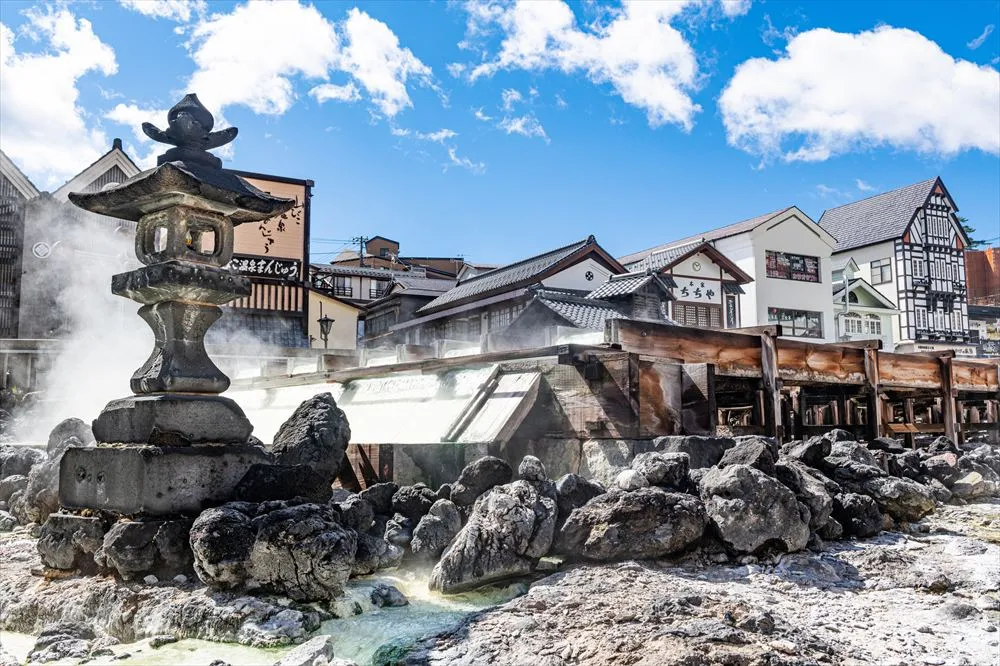SHIZUOKA (ATT.JAPAN ISSUE 44)
SHIZUOKA

Situated near the midpoint of Japan, Shizuoka Prefecture lies east to west along the coast of the Pacific Ocean like a rather thin strip of land. It used to be made up of three feudal domains, including Izu, Suruga, and Totoumi. It has bountiful nature such as mountains, lakes, and the sea. It also has many hot springs, mild weather, and many flower viewing sites.
The year 2009 should be a very special year for the prefecture because the Fujisan Shizuoka Airport will be opened by July in the border area between Shimada and Makinohara in the western part of Shizuoka. The prefecture has six bullet train stations on the Tokaido Shinkansen Line. This number is the largest among the prefectures where the Shinkansen runs through in Japan.
Shizuoka is one of the outstanding tea and orange producers in Japan. Shizuokans also grow melons and strawberries in greenhouses. Facing the ocean, Shizuoka is home to some well known ports, including Yaizu Port, the famous home port for long-distance fishermen who travel long distances in search of bonito and tuna. The port also handles a large catch of fish. Industries such as manufacture of musical instruments and paper- making are flourishing, and tourism and other service-sector industries are developing as well.
Within Shizuoka Prefecture ? with Mt. Fuji towering in the background ? this time we will show you around the eastern and central part, the area once called “Suruga.”
Shizuoka City
Sumpu Castle, famous as the retirement home of Tokugawa Ieyasu (1543-1616), who founded the Edo Shogunate, was located in Shizuoka City, the prefectural capital with many scenic spots including Nihondaira hill, known for being an excellent Mt. Fuji viewing spot. The castle ruins such as the castle foundation, the East Gomon Gate, and the moat are now included in Sumpu Park, reminding visitors of the atmosphere of bygone days. Toro Archaeological Site in Shizuoka City exhibits the actual remains of ancient people’s houses, rice fields, and surrounding forests. There, you can learn about the agricultural culture from the late Yayoi period (1,800 years ago). The artifacts preserved here are very valuable archaeological materials.
After Tokugawa Ieyasu lived his later life and passed away in Sumpu, he was interred in Kunozan Toshogu Shrine (later, his remains were moved to the mausoleum in Nikko Toshogu). Kunozan Toshogu Shrine, 216 meters above sea level, is dedicated to Ieyasu. Also, Kunozan is famous for its stone-wall-culture style of strawberry production. When the season comes, the area bustles with strawberry-pickers.
Some surrounding communities were incorporated into Shimizu in April, 2003. Shimizu City developed as a port town with a natural harbor along Miho Bay and Suruga Bay. The city thrived as a shipping port for tea and a home port for deep-sea fishing. But the port is not as prosperous as it once was. “Miho no Matsubara,” beautiful pine tree forests along the shore, is known for the legend of the Heavenly Maiden who shed her robe and bathed in the sea at Miho. It gives you a fine panoramic view of Mt. Fuji contrasted with the rippling ocean waves across Suruga Bay.
Known as former posting towns on the old Tokaido (Eastern Sea Road), Kambara and Yui were also incorporated into Shimizu City. The scenery of Yui appears in “The Fifty Three Stations of the Tokaido” by the celebrated woodblock print painter, Utagawa (Ando) Hiroshige (1797-1858). Yui City is home to the Tokaido Hiroshige Museum and there you can see his works.
Speaking of Yui, its specialty is sakura ebi small shrimps. Sakura ebi caught in Japan for sale are 100 percent from Suruga Bay. Although they are found in neighboring Sagami Bay and in Tokyo Bay, Suruga Bay is only place allowed for fishing of sakura ebi. The main fishing seasons are from April to June and from October to November. You can enjoy them fresh, boiled, or deep-fried and prepared in tempura batter. It is one of the tastes peculiar to Shizuoka.
Shizuoka local food has recently been popular. Shizuoka oden (a stew-like Japanese dish consisting of fish cake and vegetables) features strong soy sauce and a broth made with beef sinew. Shizuokans use “kuro hampen,” gray sardine cake instead of “hampen,” light puffy white fish cake. Shizuoka oden is served with bonito flakes and green laver powder sprinkled over the dish, which is unique to Shizuoka oden. Abekawa mochi is a sweet known as a Shizuoka specialty and which is a soft rice cake sprinkled with kinako (roasted soy bean powder and sugar) and “an” red bean paste.
Mt. Fuji
Mt. Fuji is the highest mountain in Japan. It straddles the boundary between Shizuoka and Yamanashi prefectures. Countless artists have been inspired by the awe of Mt. Fuji, including “ukiyoe” artist Katsushika Hokusai (1760-1849), whose masterwork “Thirty-six Views of Mount Fuji” was produced in the early 19th century; Utagawa Hiroshige, another ukiyoe painter in the Edo period; and Munakata Shiko (1903-1973), a prominent woodblock-print artist. The charm of Mt. Fuji is different depending on the viewing points, the seasons, and the time or day you see it. Words cannot adequately describe its allure.
The official climbing season is usually from July 1st to August 31st (two months). The major routes from the Shizuoka Prefecture side are from Fujinomiya, Gotemba, and Subashiri. At the foot of Mt. Fuji, cities such as Gotemba, Susono, Mishima, Numazu, Fuji, and Fujinomiya have shrines and temples religiously related to this originally holy mountain.
Gotemba, Susono, and Mishima
Gotemba City serves as a starting point for Hakone mountaineering and for sightseeing spots around Mt. Fuji. But recently many people come to shop at an outlet mall, Gotemba Premium Outlet. Take highway buses, or the Odakyu Line from Shinjuku, Tokyo, and you will enjoy shopping and viewing Mt. Fuji at the same time.
Fuji Safari Park (zoo) is in Susono City. Here you can see unconfined animals very close up from buses and cars with Mt. Fuji as backdrop.?
Mishima City has a Shinkansen Line station. It takes less than an hour from Tokyo. The famous Mishima Taisha Shrine is one of the largest shrines in the Tokai area. The construction date is unknown, but the name of Mishima Taisha Shrine was found in records written in the Nara and Heian periods (8th to 11th centuries). Mishima City was prosperous as a “shrine town” town originally built in front of the Mishima Taisha Shrine. During the Edo period, it was also a busy town as one of the posting stations on the old Tokaido. Mishima is also known for eel cultivation, along with Hamamatsu City. The local eels are considered especially fresh because they treated in a special way called “ikijime,” using spring water from Mt. Fuji sources. The ikejime technique is the way they cut parts of the fish and wash the blood off for preservation. You can taste delicious kabayaki grilled eels. Mishima City is also a gateway to such hot spring resorts in the Naka Izu area as Izu Nagaoka, Ohito, and Shuzenji.
Numazu, Fuji, and Fujinomiya
Numazu is a fishing port city located at the top of the Izu Peninsula which faces Suruga Bay. The present Numazu Goyotei Kinen Koen (Numazu Imperial Villa Memorial Park) was previously an imperial summer retreat for the Imperial family. It is recommended that you visit Numazu fish market. It doesn’t take long and you can take a JR Bus from JR Numazu Station. Numazu is the Number One producer of dried horse mackerel in Japan. At the fish market, very fresh seafood is sold and you can also enjoy tasty sushi and seafood at the restaurants inside the fish market. Also, many kinds of seafood are available as souvenirs.
Fuji City is one of the best spots from which to enjoy a panoramic view of Mt. Fuji. Paper-making has long been thriving in this area and there are many manufacturers. In the later Heian period in 1180, the Battle of Fujigawa between the Genji Clan and the Taira Clan broke out along the Fujigawa River, which is counted as one of Japan’s three fastest flowing streams. Minamoto no Yoritomo, the leader of the Genji Clan, defeated the Taira Clan. With that, he gained a strong foothold and was able to open the Kamakura Shogunate in Kamakura, Kanagawa Prefecture, ushering in a new era in Japanese history.
Fujinomiya City was a “shrine town” that thrived in front of Fujisan Hongu Sengen Shrine. In the northern part of the city lies Asagiri Kogen Heights, blessed with beautiful natural surroundings at the foot of Mt. Fuji. Both the Shiraito Fall and the Otodome Fall have been selected as two of the 100 great waterfalls of Japan. Lake Tanuki is known as one of the best photo-taking spots for the natural phenomenon referred to as “Diamond Fuji,” the sunrise touching the top of Mt. Fuji, which looks like a diamond on the top of the mountain. The city also has a natural monument sightseeing spot, called Hitoana, which is a cave created out of the cracks of lava.
Fujinomiya Yakisoba has recently been drawing attention since the noodle won the first (2006) and second (2007) championships of the B-1 Grand Prix in a row. B-1 Grand Prix is a championship contest wherein the best “B-class gourmet item” (a cheap but tasty dish) is decided. Fujinomiya Yakisoba suddenly became famous nationwide after the victories. The noodle is characterized by its chewiness and is sprinkled with meat lees or “nikukasu” and bonito flakes.??
It may seem difficult to introduce Shizuoka Prefecture without emphasis on Mt. Fuji. Nevertheless, each city features something unique to the community and each has its own natural beauty and resources other than Mt. Fuji.
In this article, we have introduced the central and eastern part of Shizuoka Prefecture. We have already featured the Izu area in the fall of 2006. Please look at our website and check out tourist information regarding Izu. (www.att-japan.net)
Shizuoka has good transportation systems, fresh vegetables, and delicious seafood. It also has many hot spring resorts. It is guaranteed that you can enjoy your traveling, viewing magnificent Mt. Fuji all along the way.


_R.webp)
.jpg)



